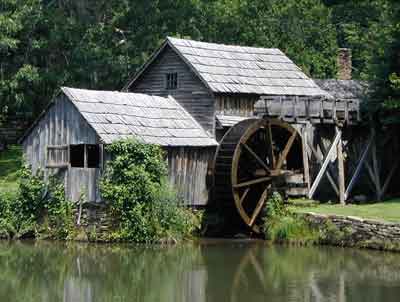|
The Water Wheel
The water wheel is an age old invention that has been used for everything from grinding grain to generating electricity. It is a machine used for converting the energy of flowing water into more useful forms of power, a process otherwise known as hydropower. As early as the 1st century BC, the ancient Greeks and Romans used waterwheels (an ancestor of the water turbine) to grind grain.
In the Middle Ages, waterwheels were used as tools to power factories. The alternatives were the windmill and human or animal power. The most common use was to mill flour in gristmills, but other uses included foundry work and machining. A waterwheel and mill combination is called a watermill. A waterwheel consists of a large wooden or metal wheel, with a number of blades or buckets arranged on the outside rim forming the driving surface. The two main types are the vertical and horizontal wheels. There are also different designs of these types. Most commonly, the wheel is mounted vertically on a horizontal axle, however the Norse wheel is mounted horizontally on a vertical shaft. Vertical wheels can transmit power either through the axle or via a ring gear and typically drive belts or gears; horizontal wheels usually directly drive their load. A channel is created to direct water to or from a waterwheel. This is called a mill race or simply a "race". The race is typically divided into two sections. The race bringing water from the source to the wheel is a headrace while the race carrying water after it has left the wheel is commonly referred to as a tailrace. A mill pond is formed only when a flowing stream is dammed to capture water to drive the water wheel. Return From Water Wheel To Home Page |






